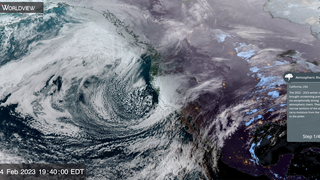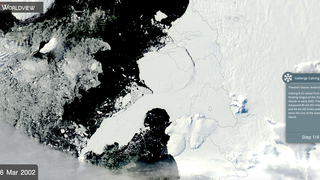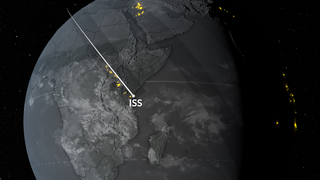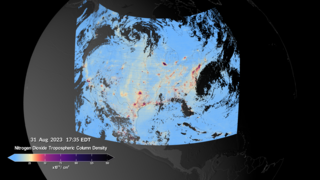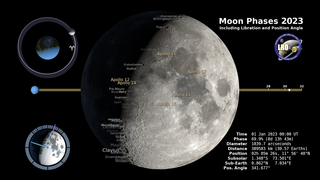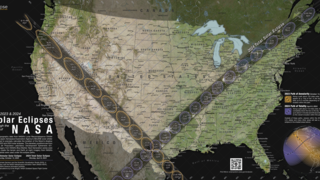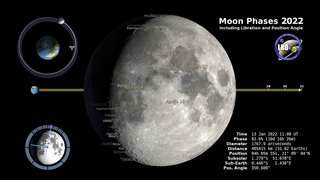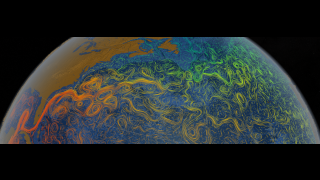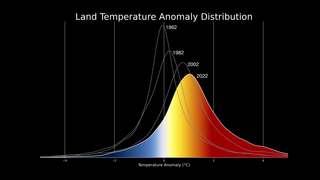Sun
ID: 4987
Magnetic reconnection is one of the most complex processes known for converting energy from magnetic fields to particle motion. It takes place in solar flares and regions of planetary (and stellar) magnetospheres. Having been studied since the 1950s, many details of the process are still undergoing study.
One of the key components in magnetic reconnection is the collision of two magnetic field regions with opposite-directed field lines, imbedded in a plasma. The field and plasma combination forms an X-shaped configuration at their closest, and most intense point.
These visualizations are plotted from a reconnection model generated by VPIC (Vector Particle-In-Cell) code. Quantities are plotted in 'dimensionless' coordinates, that are normalized to the ion inertial length (di).
The magnetic vector potential is represented by the blue-green curves which dip inward from the top and sides of the plot. This forms the 'X' region that confines the electric current (gold) which is directed out of the plane of the plot (towards the viewer). The Electron Diffusion Region (EDR) is the intense horizontal oblong blob near the center of the plot.
Electrons and ions (plasma) flow into the region from the top and bottom of the plot, initially moving together. As the plasma moves into regions with less intense magnetic field and stronger electric current, the ion and electron trajectories begin to diverge, driven by the Hall effect (Wikipedia). This accelerates and channels the flow of particles outward, through the left and right wings of the 'X', where the magnetic energy density is lowest. The net process is magnetic energy is converted into particle energy.

The incoming magnetic energy is diverted and transported to the downstream region leaving an energy void at the X-line.

Fast Magnetic Reconnection and the Hall Effect
One of the key components in magnetic reconnection is the collision of two magnetic field regions with opposite-directed field lines, imbedded in a plasma. The field and plasma combination forms an X-shaped configuration at their closest, and most intense point.
These visualizations are plotted from a reconnection model generated by VPIC (Vector Particle-In-Cell) code. Quantities are plotted in 'dimensionless' coordinates, that are normalized to the ion inertial length (di).
The magnetic vector potential is represented by the blue-green curves which dip inward from the top and sides of the plot. This forms the 'X' region that confines the electric current (gold) which is directed out of the plane of the plot (towards the viewer). The Electron Diffusion Region (EDR) is the intense horizontal oblong blob near the center of the plot.
Electrons and ions (plasma) flow into the region from the top and bottom of the plot, initially moving together. As the plasma moves into regions with less intense magnetic field and stronger electric current, the ion and electron trajectories begin to diverge, driven by the Hall effect (Wikipedia). This accelerates and channels the flow of particles outward, through the left and right wings of the 'X', where the magnetic energy density is lowest. The net process is magnetic energy is converted into particle energy.

The incoming magnetic energy is diverted and transported to the downstream region leaving an energy void at the X-line.

For More Information
Visualization Credits
Tom Bridgman (Global Science and Technology, Inc.): Lead Visualizer
Yi-Hsin Liu: Lead Scientist
Mara Johnson-Groh (Wyle Information Systems): Lead Writer
Laurence Schuler (ADNET Systems, Inc.): Technical Support
Ian Jones (ADNET Systems, Inc.): Technical Support
Yi-Hsin Liu: Lead Scientist
Mara Johnson-Groh (Wyle Information Systems): Lead Writer
Laurence Schuler (ADNET Systems, Inc.): Technical Support
Ian Jones (ADNET Systems, Inc.): Technical Support
Please give credit for this item to:
NASA's Scientific Visualization Studio
NASA's Scientific Visualization Studio
Science Paper:
First-Principles Theory of the Rate of Magnetic Reconnection in Magnetospheric and Solar Plasmas
Short URL to share this page:
https://svs.gsfc.nasa.gov/4987
Mission:
Magnetospheric Multiscale (MMS)
Data Used:
Note: While we identify the data sets used in these visualizations, we do not store any further details nor the data sets themselves on our site.
This item is part of this series:
Wave and Plasma Zoo
Keywords:
SVS >> Magnetic Fields
SVS >> Magnetic Reconnection
SVS >> Plasma
SVS >> Model Data
NASA Science >> Sun
SVS >> Model Simulation
SVS >> Computer Simulation
First-Principles Theory of the Rate of Magnetic Reconnection in Magnetospheric and Solar Plasmas
Short URL to share this page:
https://svs.gsfc.nasa.gov/4987
Mission:
Magnetospheric Multiscale (MMS)
Data Used:
Vector Particle-In-Cell Project also referred to as: VPIC
Model - LANL
Open-Source Vector Particle-In-Cell (VPIC) plasma code.
This item is part of this series:
Wave and Plasma Zoo
Keywords:
SVS >> Magnetic Fields
SVS >> Magnetic Reconnection
SVS >> Plasma
SVS >> Model Data
NASA Science >> Sun
SVS >> Model Simulation
SVS >> Computer Simulation
